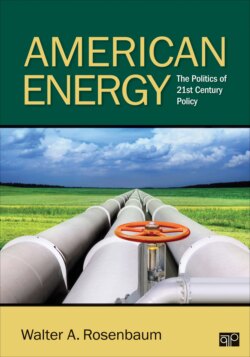Читать книгу American Energy - Walter A. Rosenbaum - Страница 25
На сайте Литреса книга снята с продажи.
Environmentalism
ОглавлениеThe environmental movement created a political fusion in which energy and environmental issues are now tightly and durably bonded. A political symmetry emerges: energy policy is now environmental policy; environmental policy is energy policy. The presence of environmentalism in all public discourse about energy policy has become an elemental force in shaping energy regulatory policies and public attitudes about energy regulation.
A recurrent theme in subsequent chapters on specific energy resources is their environmental implications. A few preliminary statistics can suggest the pervasive scope of environmental effects at every stage of energy use—extraction, refining, transportation, and consumption:
Electric utilities produce about 66 percent of the sulfur oxides air emissions in the United States.46
More than 33,000 abandoned hard rock mines, primarily associated with coal extraction, created serious environmental degradation in the twelve western states and Alaska.47
Fossil fuel mining is a major source of surface and groundwater contamination by acid mine drainage; heavy metal contamination; and leaching, soil erosion, and sedimentation.
Environmental standards also influence the market price and competitiveness of different energy sources. Safety standards, for example, raise the capital cost of commercial nuclear power facilities and diminish the competitiveness of nuclear power in many markets where it competes with fossil fuels for electric power generation.
The compounding of environmentalism with energy production defines contemporary public debate about national energy management in several important respects. Current public discussion about energy policy is often framed as a “trade-off” between the various benefits of energy development and environmental protection—or, more fundamentally, as a debate about whether such a trade-off even exists. Public opinion polls, for example, frequently suggest that most of the public perceives, or can be persuaded to perceive, that energy and environmental protection are competing priorities.
Coupling environmental values with energy production has also become a defining framework in policy debate over the future of the public domain that constitutes one-fourth of America’s continental land, the greatest natural inheritance still held by the federal government in trust for the American people. The western public lands are estimated to have a potential to generate wind and solar energy equal to almost three times current US electric generating capacity.48 But much of this ecologically valuable land is fragile biosphere, inhabited by endangered species or valued culturally and esthetically by those who fear the degradation may come in the form of renewable energy technologies like solar and wind power.
Another increasingly significant instance of environmentalism’s impact upon the course of national energy development is the association of conventional energy production with global climate warming. Environmental opponents of aggressive new fossil fuel development and proponents of increased fossil fuel production both recognize that public belief about the credibility of human-induced global climate change and its basis in fossil-fueled combustion can powerfully influence public preferences for future domestic energy production.
